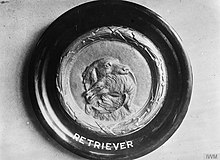HMS Retriever (1917)
Design and development
Retriever was one of three R-class destroyers ordered by the British Admiralty from Thornycroft of Woolston, Southampton, in July 1915 as part of the Sixth War Construction Programme. The ships differed from the six preceding Thornycroft M-class built by the yard, in having all geared turbines and the aft gun being raised on a bandstand. Like other Thornycroft-built vessels, they differed from the rest of the R class in having flat sided funnels.
Retriever had a long overall of 274 feet 3 inches (84 m), with a beam of 27 ft 3 in (8.31 m) and a draught of 9 ft (2.7 m). Displacement was 1,035 long tons (1,052 t) normal and 1,208 long tons (1,227 t) at deep load.Three Yarrow boilers fed steam to two sets of Brown-Curtis geared steam turbines rated at 27,000 shaft horsepower (20,000 kW) and driving two shafts, giving a design speed of 35 knots (65 km/h; 40 mph). Three funnels were fitted. A total of 296 long tons (301 t) of fuel oil was carried, giving a design range of 3,450 nautical miles (6,390 km; 3,970 mi) at 20 knots (37 km/h; 23 mph).
Armament consisted of three single 4-inch (102 mm) Mk IV guns on the ship's centreline, with one on the forecastle, one aft on a raised bandstand and one between the second and third funnels. A single 2-pounder 40 mm (2 in) "pom-pom" anti-aircraft gun was carried, along with four 21-inch (533 mm) torpedoes in two twin rotating mounts.
Construction and career
Retriever was laid down in January 1916 and launched on 15 January 1917. On being completed in March 1917, the ship joined the Harwich Force, serving as part of the Tenth Destroyer Flotilla until the end of the war. On 4 June the vessel formed part of a flotilla led by the light cruiser Undaunted that escorted the Erebus class monitors Erebus and Terror in their bombardment of Ostend. The flotilla was tasked with patrolling Schouwen Bank, but encountered no opposition. Between 16 and 17 October, the destroyer was again called upon to be part of an even larger force of 84 warships sent out to search for a German fleet based around a minelayer, although once again Retriever saw no action. The ship was credited with the destruction of the submarine SM UB-54 with depth charges on 12 March 1918 with the destroyers Sturgeon and Thruster but this has been disputed. The destroyer was subsequently equipped to tow a lighter which carried a seaplane, but a lack of wind meant that operations were curtailed at the first attempt to launch the aircraft on 10 August.
Placed in reserve after the Armistice, Retriever was allocated to the Home Fleet, serving under the dreadnought battleship King George V. However, in 1923, the Navy decided to scrap many of the older destroyers in preparation for the introduction of newer and larger vessels. The destroyer was sold for breaking up on 26 July 1927 to Hughes Bolckow of Blyth.

Pennant numbers
| Pennant number | Date |
|---|---|
| F64 | September 1915 |
| H89 | February 1915 |
| F58 | January 1918 |
| D89 | November 1918 |
| G66 | January 1919 |
| H42 | January 1922 |
References
Citations
- ^ Friedman 2009, p. 310.
- ^ Parkes & Prendergast 1969, p. 106.
- ^ Preston 1985, p. 80.
- ^ Preston 1985, p. 81.
- ^ "Harwich Force". Supplement to the Navy List Showing Organisation of the Fleet, Flag Officers' Commands &c.: 13. July 1917. Retrieved 21 March 2017 – via National Library of Scotland.
- ^ "Harwich Force". Supplement to the Navy List Showing Organisation of the Fleet, Flag Officers' Commands &c.: 13. October 1918. Retrieved 21 March 2017 – via National Library of Scotland.
- ^ Newbolt 1931, pp. 45–46.
- ^ Newbolt 1931, pp. 151–152.
- ^ Messimer 2002, p. 173.
- ^ Newbolt 1931, p. 347.
- ^ "II – Home Fleet". The Navy List: 703. October 1919. Retrieved 17 December 2020 – via National Library of Scotland.
- ^ Friedman 2009, p. 180.
- ^ Colledge & Warlow 2010, p. 338.
- ^ Bush & Warlow 2021, p. 50.
- ^ Bush & Warlow 2021, p. 76.
- ^ Dittmar & Colledge 1972, p. 71.
- ^ Bush & Warlow 2021, p. 41.
- ^ Bush & Warlow 2021, p. 66.
- ^ Bush & Warlow 2021, p. 73.
Bibliography
- Bush, Steve; Warlow, Ben (2021). Pendant Numbers of the Royal Navy: A Complete History of the Allocation of Pendant Numbers to Royal Navy Warships & Auxiliaries. Barnsley: Seaforth Publishing. ISBN 978-1-52679-378-2.
- Colledge, J J; Warlow, Ben (2010). Ships Of The Royal Navy: A Complete Record of all Fighting Ships of the Royal Navy from the 15th Century to the Present. Casemate. ISBN 978-1935149071.
- Dittmar, F.J.; Colledge, J.J. (1972). British Warships 1914–1919. Shepperton: Ian Allan. ISBN 978-0-71100-380-4.
- Friedman, Norman (2009). British Destroyers: From Earliest Days to the First World War. Barnsley, UK: Seaforth Publishing. ISBN 978-1-84832-049-9.
- Messimer, Dwight R. (2002). Verschollen: World War I U-boat Losses. Annapolis: Naval Institute Press. ISBN 978-1-55750-475-3.
- Newbolt, Henry (1931). Naval Operations: Volume V. History of the Great War. London: Longmans, Green and Co.
- Parkes, Oscar; Prendergast, Maurice (1969). Jane's Fighting Ships 1919. Newton Abbott: David & Charles. OCLC 907574860.
- Preston, Antony (1985). "Great Britain and Empire Forces". In Gardiner, Robert; Gray, Randal (eds.). Conway's All the World's Fighting Ships 1906–1921. London: Conway Maritime Press. pp. 1–104. ISBN 978-0-85177-245-5.